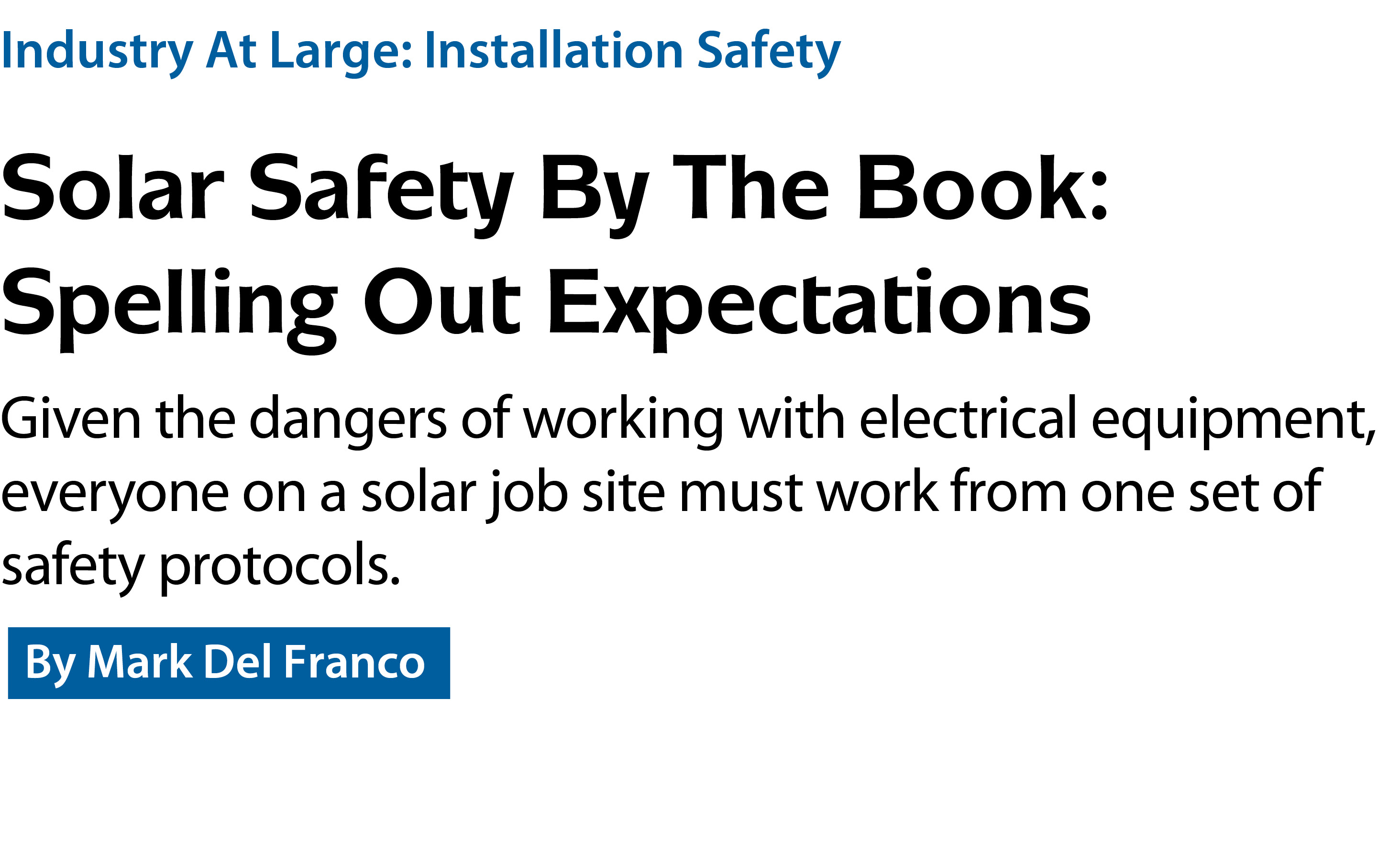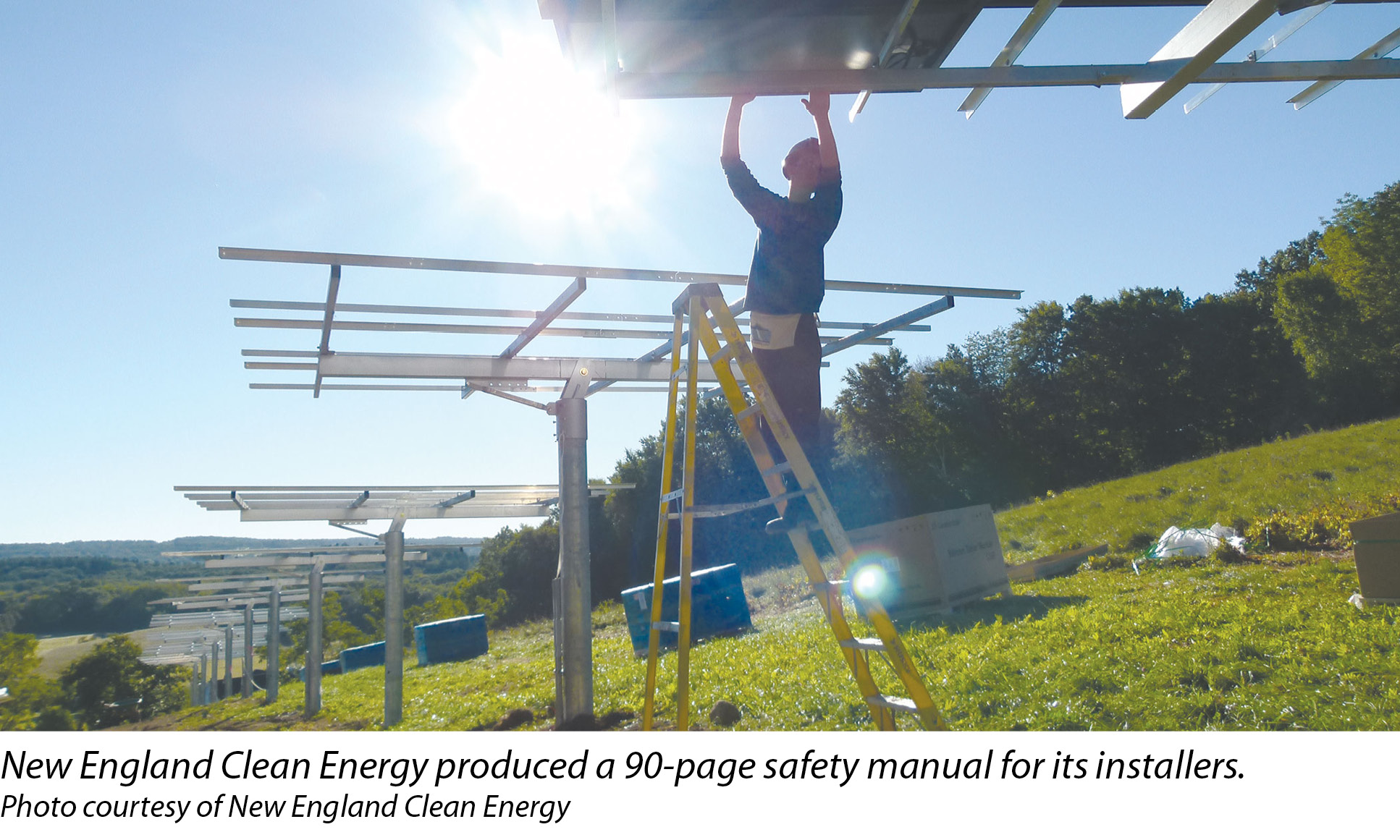

301 Moved Permanently
When exposed to direct sunlight, solar panels begin to generate electricity from the moment the modules are uncrated and the protective film is removed. Therefore, installers are never far removed from the hazards of working with electrical equipment.
And while companies adhere to federal safety standards from the U.S. Occupational Safety and Health Administration (OSHA), the National Fire Protection Association, and the Institute of Electrical and Electronics Engineers, many have made installation safety a top priority.
In fact, installers and developers have enacted dedicated safety manuals that not only ensure that solar panels are installed properly, but that their workers remain safe in the process.
“When we hire licensed electricians, they clearly understand the job parameters. But working with electricity deserves respect,” says Jonathan Williams, a partner at Hudson, Mass.-based New England Clean Energy, a designer and installer of solar electric systems. “Everyone should have a safety manual.”
The company, which was founded in 2006, claims to be one of the first New England installers to have a dedicated safety manual for solar installations. The 90-page manual, which includes non-electrical hazards, including roof work, ladder safety, personal protective equipment, and excavation and trench safety, is merely one aspect of the company’s safety culture, Williams says.
The company’s policy is to adhere closely to the basic OSHA requirements and avails itself of the agency’s Outreach Training Program, a class that helps workers recognize electrical and safety hazards. The course, which is offered in 10-hour or 30-hour sessions, is administered by OSHA-authorized trainers that grant OSHA certification upon completion. Although the 30-hour version is geared for management, the company intends to have all of the company’s eight full-time installers complete the program.

“That way, the newest installers will receive the same level of instruction as the most senior employees,” Williams says.
Installation safety is also a point of emphasis at Charlotte, N.C.-based Duke Energy. As an electric utility, few understand the potential job hazards better than Duke. Just the same, the company leaves nothing to chance, especially when dealing with outside contractors, notes Jim Barfield, Duke Energy’s lead environment, health and safety (EHS) professional.
According to Barfield, each of Duke’s ground-mounted solar sites under construction begins with an EHS plan that outlines company protocols and safety procedures. Going one step further, the company also requires prospective ground-mounted solar contractors to also file an EHS plan.
Barfield says Duke’s safety manual addresses potential hazards in most general working environments and, more importantly, how to mitigate them. Often, however, the contractor may have its own set of policies or standards governing installations which may not align with those of the developer.
“As part of the plan, we require installers to provide completed job hazard analyses on critical or high-risk tasks, which we review to ensure completeness and adherence to the intent of the process,” Barfield says. “Upon review, if a vendor’s plan doesn’t measure up to Duke Energy standards, we require them to revise it or use our plan for the site.”
He says the plan focuses on the specific conditions present at the site and the steps taken to ensure employees and contractors are working safely and in compliance with environmental policies.
“The greatest hazard is the potential exposure to live electricity, and we reinforce the hazards related to electricity among our contractors and installers.”
From a mechanical and physical standpoint, Duke Energy has developed some rooftop solar installations that have posed additional safety issues due to height and space limitations. In such cases, Duke refers to the OSHA standard for construction (29 CFR 1926) and the American National Standards Institution’s fall protection code (ANSI 359), among other professional sources.
Boston-based wind and solar developer First Wind also makes it a point to review and discuss safety plans with third-party installers, says Claude Cote, the company’s vice president of safety and compliance. Such pre-construction collaboration is the key to protecting installers, he says.
Clearly identifying responsibilities and having one set of rules by which everyone abides - employees and contractors - is the best way to keep everyone safe.
“If you’re using a general contractor for construction, they are typically the ones controlling the work,” Cote says. “If you’ve done your due diligence in selecting the firm, chances are that you’ll also have a comfort level with their safety rules. The bottom line is someone has to be in charge.”
Once the project has been completed and energized, contractors typically adhere to the safety protocols of the owner, he says.
As solar energy continues to evolve, so will standards and protocols. Clearly, there is much to be done on the safety front. For example, the Solar Energy Industries Association does not track safety data or the rate of safety incidents.
Absent an industry-specific standard, most companies follow OSHA’s classification system. OSHA uses the North American Industry Classification System developed by the U.S. Census Bureau to classify the industry from which injuries originate. There have been revisions, but for general electric generation, the code is 22111 with add-on digits for specific industries such as hydroelectric (221111), fossil fuel (221112), nuclear (221113), etc.
It wasn’t until the 2012 revision that they added solar (221114), wind (221115), geothermal (221116) and other classifications specific to renewable energy industries. While OSHA has the ability to accept the data in the new categories, it is not known how many companies have yet to implement the new classification categories; therefore, many solar-related issues may still be folded into the older categories.
Duke Energy tracks this data not only for its employees, but also for the contractors working on its sites. This policy is intended to turn the information gleaned from historical reports into a proactive safety policy.
Duke Energy has instituted a program of conducting contractor job observations. The company says it has completed more than 500 contractor observations this year through its renewables unit. Within Duke Energy, these are tracked as proactive safe behaviors and are part of the company’s annual incentive plans.
According to Barfield, developers and installers are able to use the information to police each other.
“We feel that we have a responsibility to ensure a safe and environmentally friendly setting for all those working on our sites, as well as the community at large,” he says. “Our employees observe contractors as well as fellow Duke employees working on-site to both identify hazardous situations and positively reinforce safe behavior.”
New England Clean Energy has also taken to using financial incentives, such as cash bonuses, to ensure safety during installations. The incentive program, which is currently being revamped, is based on safety, customer satisfaction, quality of work and efficiency. R
Industry At Large: Installation Safety
Solar Safety By The Book: Spelling Out Expectations
By Mark Del Franco
Given the dangers of working with electrical equipment, everyone on a solar job site must work from one set of safety protocols.
si body si body i si body bi si body b
si depbio
- si bullets
si sh
si subhead
pullquote
si first graph
si sh no rule
si last graph